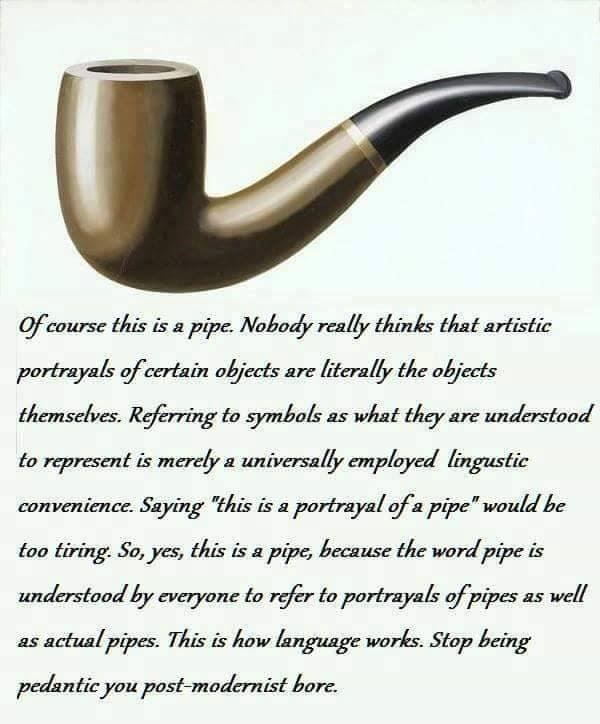
I’ve been pretty vocal in past articles here at Nine Points about the dangers of becoming too identified with your Enneagram type—I cringe when I see someone wearing jewelry or clothing reflecting their Enneagram type, and my pre-frontal cortex tends to take a nap whenever I hear people referring to their type in normal conversation. (Is there anything more boring than hearing someone explain mundane actions as being rooted in their fixation, or saying “As a Type One, I tend to …”?)
That said, I think that it is silly to strenuously object to the use of the word “type” when discussing the Enneagram, and I have been criticized by Facebook Enneagram forum commenters for doing so. Some have even posted a copy of Magritte’s painting “The Treachery of Images” in an effort to persuade me off use of “type.” Those “type” critics miss the point.
When Belgian artist Rene Magritte painted a pipe and wrote beneath it “Ceci n’est pas une pipe” (“This is not a pipe”), he was making a point about how we always have to bear in mind the limitations of language and the need for direct experience. He was not suggesting we convolute our language and start saying things like “Magritte also painted a representation of a man with an apple in front of his face” rather than saying “Magritte also painted a man with an apple in front of his face.” Everyone knows he did not paint an actual man or apple, and pointing out the obvious makes the people around you wish you would just go away.
Besides, what would it even mean if someone believed they were a type (other than that they are clearly nuts)—that they aren’t a human being but an abstract class of objects with shared qualities?
The image that accompanies this article, which I found on the “Philosophy Matters” Facebook page, makes this point—it is almost impossible to have a conversation if we avoid terms that everyone understands just to make some point that everyone already knows. (The text from the image is reproduced below.)
The definition of “type” is very clear in this regard: qualities common to a number of individuals that distinguish them as an identifiable class. Calling someone a “type” simply means that they are a member of this category. If you don’t think that this is one of the main values that the Enneagram provides us—to understand that people are different, but that some of those differences are consistent and steady over time and it is helpful to know what kind of characteristics a given person frequently displays—you are missing out. The teaches us that we ARE a type AND that we are ALSO much more. These two lessons are not mutually exclusive. Feel free to twist yourself into linguistic contortions to make an obvious point if you want, but your constant harping on the dangers of other people not doing the same are just boring.
My preference is to use the term “Ennea-type” as it indicates a specific relationship the class being identified to the Enneagram. When I use it, all I am saying (and which any sensible person understands) is that I am referring to someone who has a tendency to non-consciously show a habitual (though by no means exclusive) tendency to overuse one of the particular personality strategies correlated to a specific point on the Enneagram diagram. Repeating this explanation every time would just be a silly waste of time. Arguing over this point strikes me as particularly Sophist, focusing on a distinction without a difference. So let’s get past this argument and remember, yes, we are not a “type,” but it is a distraction to become so fixated on the argument that we lose touch with what the Enneagram teaches us:
While we are all unique individuals, we also tend to fixate into the same patterns that a broad subset of humanity does; that in order to gain freedom from these patterns it helps to remember that we are the kind (or “type”) of person who falls into these traps in the first place.
“Of course this is a pipe. Nobody really thinks that artistic portrayals of certain objects are literally the objects themselves. Referring to symbols as what they are understood to represent is merely a universally employed linguistic convenience. Saying “this is a portrayal of a pipe” would be too tiring. So, yes, this is a pipe, because the word pipe is understood by everyone to refer to portrayals of pipes as well actual pipes. This is how language works. Stop being a pedantic you post-modernist bore.”

